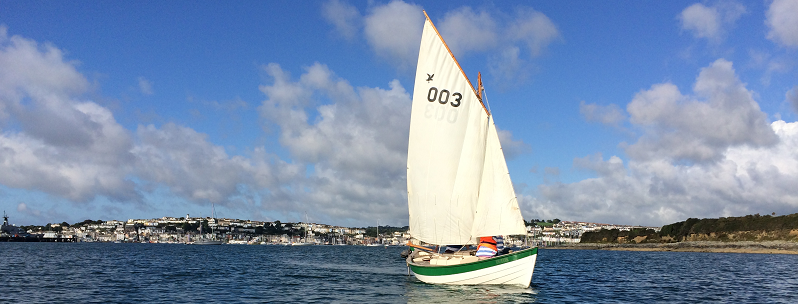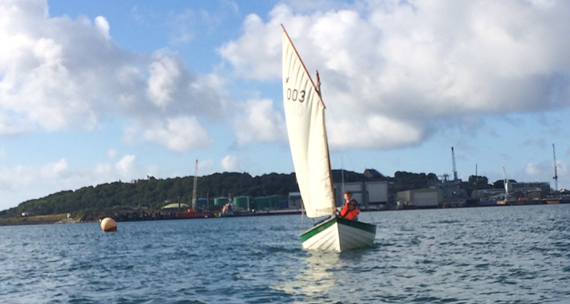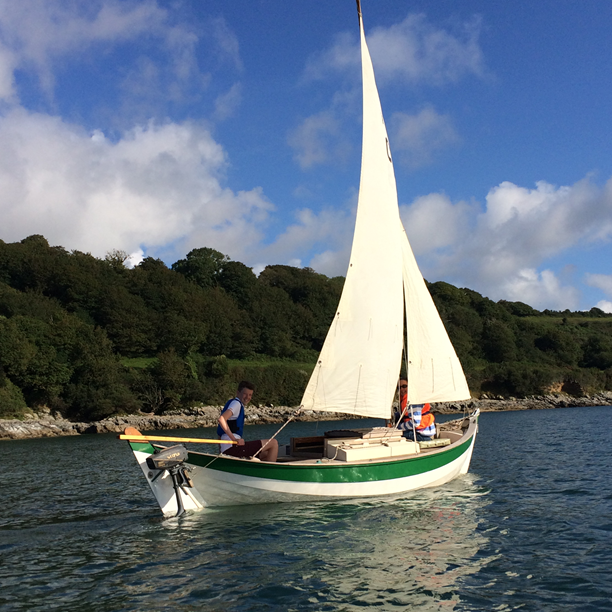
The Longshore 16 is a traditional design 16 foot trailer-sailor. Good looking, well built, very stable, simple to launch and sail – she is ideal for harbour, estuary, and coastal sailing, while sturdy enough to endure stronger winds or attempt more adventurous passages.
—
Design and build
The Longshore 16 was built during the late eighties and nineties by Longshore International in the UK, originally by Peter Harris of Winterbourne Monkton in Wiltshire, then in 1994 by Longshore International LLP of Huntingdon, Cambridgeshire. I have been told informally that Peter Harris was the designer; but have not been able to confirm this. A pdf of the 1993 sales literature can be found here
The makers said that the design is based on a Portpatrick fishing boat – double ended (ie pointed at both ends) with a hatch opening to a large cabin (which would have been the hold in the original design).
She is constructed from GRP but has teak-laid decks and teak gunnel cappings. The hull has wide clinker-style lands and the mast, yard and tiller are wood. Many metal fittings – fairleads, rudder hinges, rowlocks – are bronze (load-bearing shroud and stay fittings are stainless).
A horizontal sliding hatch opens to a cosy cushion-lined cabin. The cabin is ideal for storing all the stuff you need for sailing – picnic, oilies, flares – but is large enough to store an inflatable dinghy (when deflated), bodyboards, etc. It is also an excellent safe space to store children, who love hiding down below. It will even sleep 2 (provided you are good friends!)
The build quality and attention to detail are superb. Altogether, she is a very attractive boat.

—
Sails and Rig
Rig is standing lug mainsail with a jib. Sails are made from Dacron. The mainsail is loose-footed (ie no boom to knock you overboard when gybing). The small jib hanks on to the forestay. The main has two sets of reefing points. The wooden mast is held in place by polypropylene rope shrouds and a stainless wire forestay.

—
On the water
Sailing her is a cinch. The simple jib- and main-sheets have no blocks or pulleys and lead straight back to the cockpit for cleating. The rudder is large and well balanced, the long tiller needing only light pressure.
She draws only 18 inches, allowing access up shallow rivers and creeks. Even then, if you do go aground, just push off with a boathook – or hop overboard and push (you won’t get the hem of your shorts wet). The shallow draught also allows you to sail straight up onto the beach and discharge your cargo of family/dog/picnic without getting wet feet!
She is quite beamy and weighs 500kg, most of which is ballast in her long keel. This makes her very stable even in strong winds. There are two water-tight compartments at the fore and aft ends. The makers claimed she was self-righting and unsinkable (but then so was the Titanic!) – has anyone put this to the test?.
With a good breeze she will sail at 45 degrees to the wind and will tack through 90 degrees, with a gentler breeze it will be closer to 55/110 degrees.
A pair of oars and rowlocks (optional extras) along with a small thwart, or taft, that fits into the cockpit enable her to be rowed. Or, (again an option) an auxiliary 2HP outboard that clamps to a clever swivelling bracket that puts the prop directly behind rudder enables her to be motored.

—
Towing and Launching
The total weight (boat + trailer) is about 750kg or three-quarters of a ton. So ideally, a medium-sized car is needed for towing. (I can confirm that a Peugeot 306 with 1.6 litre non-turbo engine struggles a bit up hills – I can end up in 2nd or 3rd gear at 20-30 mph)
Launching is very quick and easy – like a dinghy (except that even two people can’t carry her!) From arriving at the slipway to floating her off takes half an hour – or 15 minutes if you set her up for ‘quick launch’.
- remove the lightboard,
- erect the mast (which can be left with shrouds attached – just tie down the forestay);
- hank the jib onto the forestay and feed the jibsheets through the fairleads;
- attach the yard (which can be left with the mainsail laced on) to the main halyard and downhaul with snapshackles;
- hang the rudder (which again can be left on while towing)
- reverse down the slip.
More information
‘Spotted’ on this website, which is a collection of Longshore sightings including For Sale ads, from around the web
The Longshore 16 Facebook page, including an excellent video of a Longshore in a breeze
They occasionally popup in the Small Traditional Sailing Boats Facebook page
‘Pocket Cruiser’ videos on Youtube